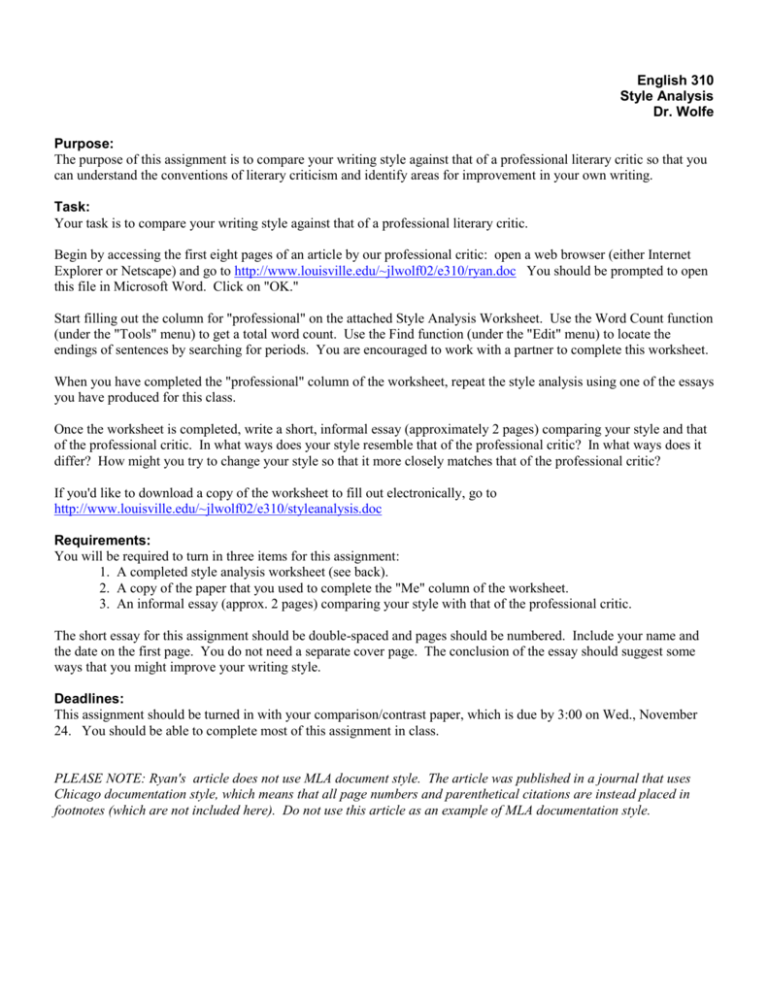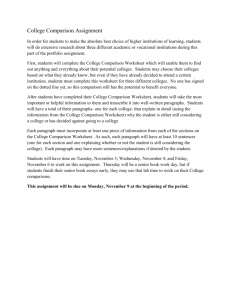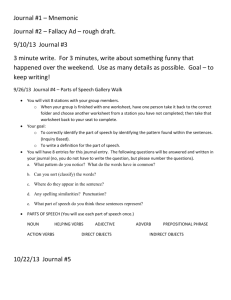Wolfe- Style Analysis Worksheet
advertisement

English 310 Style Analysis Dr. Wolfe Purpose: The purpose of this assignment is to compare your writing style against that of a professional literary critic so that you can understand the conventions of literary criticism and identify areas for improvement in your own writing. Task: Your task is to compare your writing style against that of a professional literary critic. Begin by accessing the first eight pages of an article by our professional critic: open a web browser (either Internet Explorer or Netscape) and go to http://www.louisville.edu/~jlwolf02/e310/ryan.doc You should be prompted to open this file in Microsoft Word. Click on "OK." Start filling out the column for "professional" on the attached Style Analysis Worksheet. Use the Word Count function (under the "Tools" menu) to get a total word count. Use the Find function (under the "Edit" menu) to locate the endings of sentences by searching for periods. You are encouraged to work with a partner to complete this worksheet. When you have completed the "professional" column of the worksheet, repeat the style analysis using one of the essays you have produced for this class. Once the worksheet is completed, write a short, informal essay (approximately 2 pages) comparing your style and that of the professional critic. In what ways does your style resemble that of the professional critic? In what ways does it differ? How might you try to change your style so that it more closely matches that of the professional critic? If you'd like to download a copy of the worksheet to fill out electronically, go to http://www.louisville.edu/~jlwolf02/e310/styleanalysis.doc Requirements: You will be required to turn in three items for this assignment: 1. A completed style analysis worksheet (see back). 2. A copy of the paper that you used to complete the "Me" column of the worksheet. 3. An informal essay (approx. 2 pages) comparing your style with that of the professional critic. The short essay for this assignment should be double-spaced and pages should be numbered. Include your name and the date on the first page. You do not need a separate cover page. The conclusion of the essay should suggest some ways that you might improve your writing style. Deadlines: This assignment should be turned in with your comparison/contrast paper, which is due by 3:00 on Wed., November 24. You should be able to complete most of this assignment in class. PLEASE NOTE: Ryan's article does not use MLA document style. The article was published in a journal that uses Chicago documentation style, which means that all page numbers and parenthetical citations are instead placed in footnotes (which are not included here). Do not use this article as an example of MLA documentation style. Style Analysis Worksheet You are encouraged to work with a partner to complete this worksheet. Part I: Length and Variety. Criteria Me Professional Me Professional 1. Total Number of Words (go to "Tools" then "Word Count") 2. Total Number of Sentences (go to "Edit" then "Find" and search for periods in the document) 3. Average number of Words per Sentence (divide #1 by #2) 4. Length of Longest Sentence (in words) 5. Length of Shortest Sentence (in words) 6. Number of paragraphs 7. Average number of sentences per paragraph (divide #2 by #6) 8. Length of Longest Paragraph (in sentences) 9. Length of Shortest Paragraph (in sentences) Part II: Style. Criteria 10. Number of expletive constructions (it is, there are, it was, there were) 11. Average number of expletives per sentence (divide #10 by #2) 12. Number of "to be" verbs (am, is, are, was, were, be, been, etc) 13. Average number of "to be" verbs per sentence (divide #12 by #2) 14. Number of transitional phrases (see handout on transitional devices) 15. Average number of transitional phrases per paragraph (divide #14 by #6) 16. Average number of transitional phrases per sentence (divide #14 by #2) 17. Number of direct quotations 18. Average number of quotations per paragraph (divide #17 by #6) 19. Average number of quotations per sentence (divide #17 by #2) 20. Number of first person references (I, we, us) 21. Average number of first person references per sentence (divide #20 by #2)


